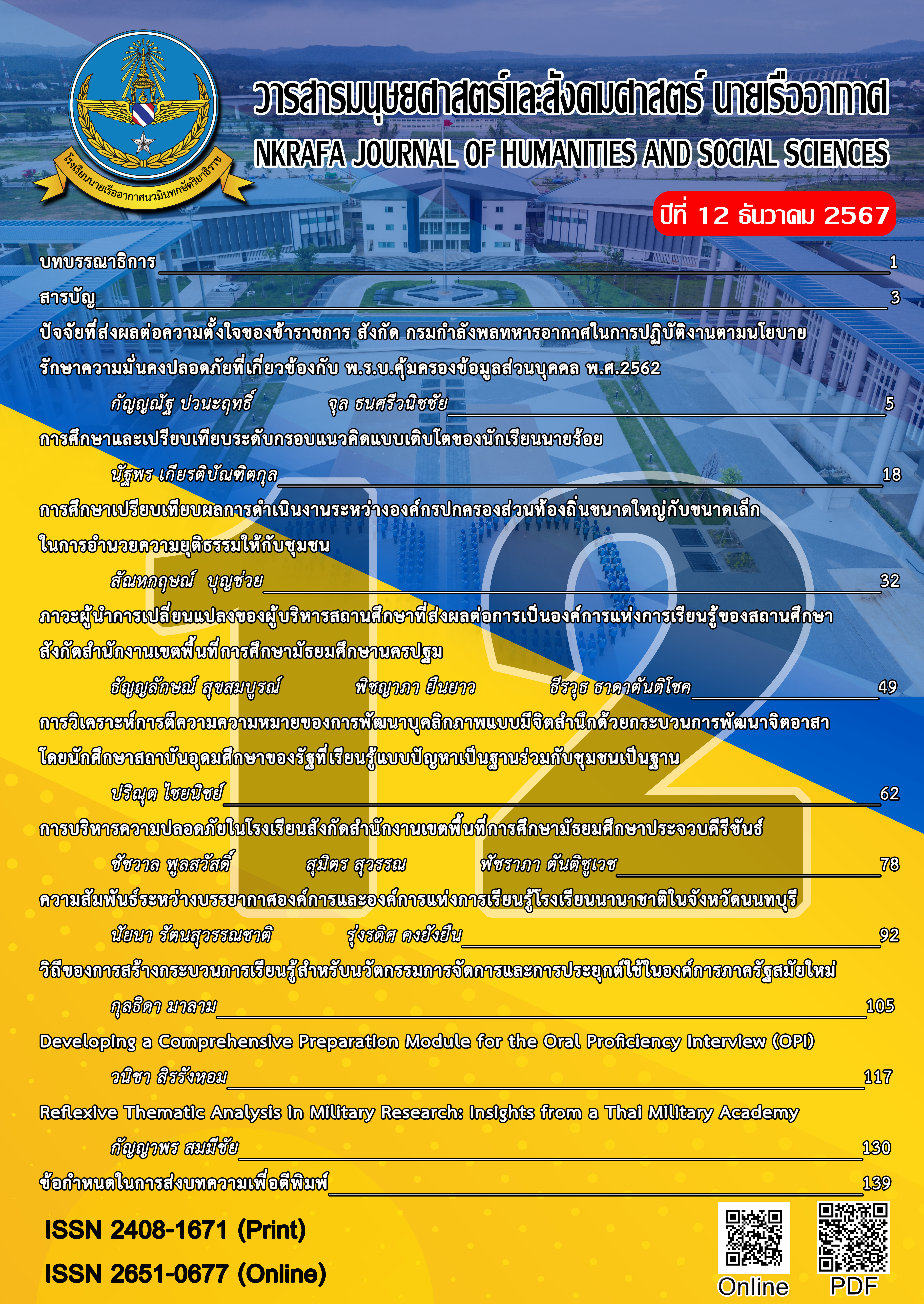Developing a Comprehensive Preparation Module for the Oral Proficiency Interview (OPI)
Main Article Content
บทคัดย่อ
Oral Proficiency Interview (OPI) is a standardized assessment tool used to measure
an individual's ability to speak a language. It evaluates oral communication skills in a natural and interactive format. For the air force personnel who wants to achieve some specific scholarship to
the Defense Language Institute English Language Center (DLIELC), needs to pass the OPI test at least level 2. However, the test takers are not familiar with the test format and there is less material for the personnel to prepare themselves for this due to the OPI is limited context. The primary objective of developing the exam-oriented Oral Proficiency Interview (OPI) module was to provide a comprehensive resource for test takers seeking to achieve the required scores for their academic or professional needs. The development process involved an in-depth analysis of the test's components to ensure that learners become familiar with and confident in
the test format by the module's completion. The design of the module was informed by
the test’s patterns and structures, incorporating scenarios and contexts that closely mirror
real-world testing situations. Additionally, vocabulary and speaking strategies were included to help learners meet the test's specific requirements. However, the limited use of the OPI test in Thailand posed challenges, including a lack of reference materials and field specialists. Despite these constraints, input from experienced consultants was instrumental in enhancing the module's effectiveness.
Article Details

อนุญาตภายใต้เงื่อนไข Creative Commons Attribution-NonCommercial-NoDerivatives 4.0 International License.
บทความที่ได้รับการตีพิมพ์เป็นลิขสิทธิ์ของวารสารมนุษยศาสตร์และสังคมศาสตร์ นายเรืออากาศ
ข้อความที่ปรากฎในบทความแต่ละเรื่องในวารสารวิชาการเล่มนี้ เป็นความคิดเห็นส่วนตัวของผู้เขียนแต่ละท่าน ไม่เกี่ยวข้องกับโรงเรียนนายเรืออากาศฯ และคณาจารย์ท่านอื่น ๆในโรงเรียนนายเรืออากาศฯ แต่อย่างใด ความรับผิดชอบขององค์ประกอบทั้งหมดของบทความแต่ละเรื่องเป็นของผู้เขียนแต่ละท่าน หากมีความผิดพลาดใด ๆ ผู้เขียนแต่ละท่านจะรับผิดชอบบทความของตนเองแต่เพียงผู้เดียว
เอกสารอ้างอิง
Acadecraft. (2023). What is curriculum sequencing and its models? Retrieved from
American Council on the Teaching of Foreign Languages. (2012). ACTFL proficiency guidelines 2012
[Electronic version]. Retrieved from
https://www.actfl.org/uploads/files/general/ACTFLProficiencyGuidelines2012.pdf
American Council on the Teaching of Foreign Languages. (2018). OPI examinee handbook 2018.
American Council on the Teaching of Foreign Languages.
American Council on the Teaching of Foreign Languages. (2020b). Oral proficiency interview
familiarization guide. Retrieved from
https://www.actfl.org/uploads/files/general/OPI-Familiarization-Guide-2020-1.pdf
American Council on the Teaching of Foreign Languages. (2020a). Modified OPI Assessment
Workshop. Retrieved from
https://www.actfl.org/uploads/files/general/Documents/Workshop-Agenda-In-Person-or-
Virtual-Synchronous-MOPI-Assessment.pdf
American Council on the Teaching of Foreign Languages. (2023). OPI Oral Proficiency Interview:
Complete Guide. Retrieved from https://englishproficiency.com
American Council on the Teaching of Foreign Languages. (n.d.). ACTFL Oral Proficiency Interview
(OPI) Rating Scale. Retrieved from https://www.actfl.org
Altun, M. (2015). The benefits of role-play activities in English language teaching. Theory and
Practice in Language Studies.
Brown, H. D., & Abeywickrama, P. (2019). Language assessment: Principles and classroom practices
(3rd ed.). Pearson.
Canale, M. (1987). The measurement of communicative competence. Annual Review of Applied
Linguistics, 8, 67-84. https://doi.org/10.1017/S0267190500001033
Chootharat, S., Veerachaisantikul, A., & Junnak, C. (2016). Using a role play to improve stress and
intonation for Thai learners. The Asian Conference on Arts & Humanities 2016: Official
Conference Proceedings. Rajamangala University of Technology Isan, Thailand.
Defense Language Institute English Language Center. (n.d.a). Who takes the OPI? Retrieved April 2, 2024,
from https://www.dlielc.edu/testing/opi_who.php
Defense Language Institute English Language Center. (n.d.b). OPI levels explained. Retrieved April 2, 2024,
from https://www.dlielc.edu/testing/opi_level.php
Dudley-Evans, T., & St John, M. J. (2000). Developments in English for specific purposes: A
multidisciplinary approach. Cambridge University Press.
Dufresne, J., & Gagnon, M. (2019). Pragmatics and functional language use in language teaching.
Springer.
Educasciences. (2023). Lesson sequencing strategies: A comprehensive overview. Retrieved from
Fraser, C., Rintell, E., & Walters, J. (1980). Role-play and its applications in assessing pragmatic
abilities. International Journal of Applied Research.
Hammond, J. (2020). Designing tests for communicative competence. Journal of Language Testing,
(2), 45-63.
Kosar, H. (2023). Content organization and sequencing [PowerPoint slides]. Department of
Education, Example University. Retrieved from
https://www.slideshare.net/DrHafizKosar/content-organization-and-sequencingpptx
Kosmala, L., Horgues, C., & Scheuer, S. (2023). A multimodal study of how pronunciation-induced
communication breakdowns are managed during tandem interactions. Research in Language,
(3), 291-312. https://doi.org/10.18778/1731-7533.21.3.05
Lafford, B. A. (2019). Challenges in assessing oral proficiency: Insights from the OPI. Language
Testing Review, 41(1), 21-38.
Lakha, S. (2023). Lesson sequencing strategies: A comprehensive overview. Educasciences.
Retrieved from https://www.educasciences.org/article/lesson-sequencing-strategies
Liskin-Gasparro, J. E. (2003). The ACTFL proficiency guidelines and the oral proficiency interview: A
brief history and analysis of their survival. Foreign Language Annals, 36(4), 483-490.
https://core.ac.uk/download/pdf/192326922.pdf
Misra-Hebert, A. D. (2003). Cultural competence in cross-cultural communication. Cleveland Clinic
Journal of Medicine, 70(4), 297–298. Retrieved from https://www.ccjm.org
Meyer, A. (2021). Building readiness for oral proficiency interviews: Teaching strategies and
challenges. Foreign Language Annals, 54(3), 369-385.
Ohidujjaman, A. H. M. (2024, November 11). Teaching ESL speaking: A complete guide for 99%
success. Retrieved from https://examplewebsite.com
Oral Proficiency Interview. (2023). OPI proficiency guidelines and level descriptors. Retrieved from
https://www.oralproficiencyinterview.org
Parry, T. S. (2014). OPI testing at the Defense Language Institute Foreign Language Center.
Retrieved from https://www.fbcinc.com/e/learn/e/assessment/presentations/tuesday/
OPI_Workshop_(Parry)_- LEARN_2014.pdf
Plengkham, B., & Wasanasomsithi, P. (2023). Effects of integrated performance assessment modules
on English speaking ability of Thai EFL undergraduate students. LEARN Journal: Language
Education and Acquisition Research Network, 16(2).
https://so04.tci-thaijo.org/index.php/LEARN/article/view/263451
Raiyn, J. (2016). The role of visual learning in improving students’ high-order thinking skills. Journal
of Education and Practice, 7(24), 115-121.
https://www.iiste.org/Journals/index.php/JEP/article/view/32907
Roy, T., Johnson, P., & Smith, H. (2023). Enhancing cross-cultural communication through training
and education. International Journal of Language Studies. Retrieved from
https://www.language-studies.org
Schorr, R. Y., & Bulgar, S. (2003). The impact of preparing for the test on classroom practice.
Retrieved from https://files.eric.ed.gov/fulltext/ED501115.pdf
Sokhanvar, Z., Salehi, K., & Sokhanvar, F. (2021). Advantages of authentic assessment for improving
the learning experience and employability skills of higher education students: A systematic
literature review. Studies in Educational Evaluation, 70, 101030.
https://doi.org/10.1016/j.stueduc.2021.101030
Zohrabi, M. (2011). Coursebook development and evaluation for English for general purposes
course. English Language Teaching, 4(2), 85-91. https://doi.org/10.5539/elt.v4n2p85


